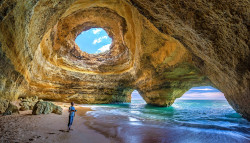Sea Caves
Littoral Caves
A sea cave is created by the wave action of the sea or a huge lake. It is therefore a form of erosion cave. Of course, there can also be sea caves in large inland waters, but these are very rare.


A sea cave is created by the forces of the sea when the waves crash against the rock face of a coast. The surf is the transformation of the kinetic energy of the waves when they reach the mainland. Surf destroys rocks, but only in the area where it is active, i.e. a few metres above and below sea level. In areas with a large tidal range, the area is somewhat larger. The waves often form very large caves, which are usually not very long. They can only be as long as the kinetic energy of the water lasts. The formation of these caves by mechanical forces is not dependent on the type of rock. Of course, it is helpful if the rock is less resistant to erosion. Much more important, however, is how long the waves act on the same spot.
Typically sea caves are formed along a weakness in the rock, like faults, different sediments or weaker layers.
Faults in the rock sometimes produce chains of caves, everywhere the fault reaches the sea shore.
(See
 Merlins Cave)
The erosion effect can be enhanced by dissolution by the aggressive salt water,
Merlins Cave)
The erosion effect can be enhanced by dissolution by the aggressive salt water,
 incasion,
and even by pre-existing caves, in general karst caves.
Already existing caves are enlarged by the coastal erosion, and the water starts to widen the cave.
Many karst areas on the coast have caves opening to the sea, where the entrance is widened by the waves.
They are often called sea caves, which is only partly true.
incasion,
and even by pre-existing caves, in general karst caves.
Already existing caves are enlarged by the coastal erosion, and the water starts to widen the cave.
Many karst areas on the coast have caves opening to the sea, where the entrance is widened by the waves.
They are often called sea caves, which is only partly true.
Sea caves are a typical result of coastal erosion. Erosion removes the rock at the base, forming a cave. The rock above it often collapses quickly, forming a steep cliff face. If the rock does not collapse, the hollow becomes deeper and deeper and at some point is called a cave. This cave is then low, extremely wide and not very long. In the tropical cone karst, there are karst towers that have a circumferential ledge. Fluctuations in sea level can even lead to the formation of several levels of such ledges.
Sea caves are just one form of this erosional process.
Spectacular are also
 natural bridges
or arches, and
natural bridges
or arches, and
 Blowholes.
The formation of natural bridges is easy to understand, here a peninsula is simply eroded from both sides, and if erosion is faster at one point, a breakthrough occurs, a natural bridge.
Somewhat more complicated are blow holes.
A small sea cave has a breakthrough, a fissure or a shaft to the surface above the cliff.
When waves slosh into the cave, pressure builds up there, forcing the water up through the vent, because of the small cross-section with enormous force.
Some blowholes are only active during storms, others also during normal swell.
The water can shoot up as high as 10 metres.
Blowholes.
The formation of natural bridges is easy to understand, here a peninsula is simply eroded from both sides, and if erosion is faster at one point, a breakthrough occurs, a natural bridge.
Somewhat more complicated are blow holes.
A small sea cave has a breakthrough, a fissure or a shaft to the surface above the cliff.
When waves slosh into the cave, pressure builds up there, forcing the water up through the vent, because of the small cross-section with enormous force.
Some blowholes are only active during storms, others also during normal swell.
The water can shoot up as high as 10 metres.
The biggest sea cave of the world is Matainaka Cave on South Island in New Zealand, which is 1,540 m long [2024].
Literature
- Examples
 Grottes de Matata
Grottes de Matata Grottes Marines de Morgat
Grottes Marines de Morgat Smoo Cave
Smoo Cave St Fillan’s Cave
St Fillan’s Cave Modra Špilja
Modra Špilja Blue Grotto
Blue Grotto Grotta dello Smeraldo
Grotta dello Smeraldo Enoshima Iwaya Cave
Enoshima Iwaya Cave Sandanbeki Dokutsu
Sandanbeki Dokutsu Playa Escondida
Playa Escondida Maori Leap Cave
Maori Leap Cave Talava Arches
Talava Arches Sea Lion Caves
Sea Lion Caves Sunny Jim Cave
Sunny Jim Cave
- See also
 Search DuckDuckGo for "Sea Caves genesis"
Search DuckDuckGo for "Sea Caves genesis" Sea cave - Wikipedia (visited: 02-JUL-2020)
Sea cave - Wikipedia (visited: 02-JUL-2020) Sea Caves - The Virtual Cave (visited: 02-JUL-2020)
Sea Caves - The Virtual Cave (visited: 02-JUL-2020) WORLD LONGEST SEA CAVES NSS (visited: 27-JUN-2024)
WORLD LONGEST SEA CAVES NSS (visited: 27-JUN-2024) Sea/Littoral Caves (visited: 18-FEB-2022)
Sea/Littoral Caves (visited: 18-FEB-2022) Coastal Erosion by Alex Jackson (visited: 02-JUL-2020)
Coastal Erosion by Alex Jackson (visited: 02-JUL-2020) Sea cave (visited: 02-JUL-2020)
Sea cave (visited: 02-JUL-2020) The 10 Most Spectacular Sea Caves Around the World (visited: 02-JUL-2020)
The 10 Most Spectacular Sea Caves Around the World (visited: 02-JUL-2020) 20 of the Most Beautiful Sea Caves in the World (visited: 02-JUL-2020)
20 of the Most Beautiful Sea Caves in the World (visited: 02-JUL-2020) Beautiful Sea Caves Around the World (visited: 02-JUL-2020)
Beautiful Sea Caves Around the World (visited: 02-JUL-2020)

 Index
Index Topics
Topics Hierarchical
Hierarchical Countries
Countries Maps
Maps